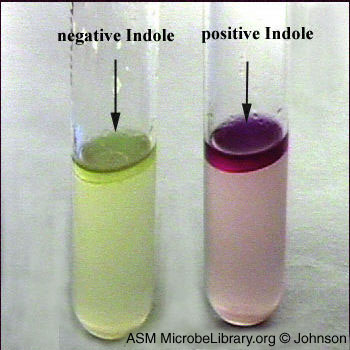靛基质(Indole)试验:
某些细菌能分解蛋白胨中的色氨酸,生成吲哚。吲哚的存在可用显色反应表现出来。吲哚与对二甲基氨基苯醛结合,形成玫瑰吲哚,为红色化合物。
试验方法:将待试纯培养物小量接种于试验培养基管,于36±1C培养24h时后,取约2ml培养液,加入Kovacs氏试剂2~3滴,轻摇试管,呈红色为阳性,或先加少量乙醚或二甲苯,摇动试管以提取和浓缩靛基质,待其浮于培养液表面后,再沿试管壁徐缓加入Kovacs氏试剂数滴,在接触面呈红色,即为阳性。
实验证明靛基质试剂可与17种不的靛基质化合物作用而产生阳性反应,若先用二甲苯或乙醚等进行提取,再加试剂,则只有靛基质或5-甲基靛基质在溶剂中呈现红色,因而结果更为可靠。

Margaret (Peg) Johnson, Mesa Community College, Mesa, Ariz., USA
This image depicts the results of negative and positive indole tests. The indole test is frequently employed to distinguish Klebsiella or Enterobacter bacteria (indole negative) from Escherichia coli (indole positive). The presence of E. coli is used by public health officials as an indicator of fecal contamination of food and water supplies.
Prior to this test, Enterobacter aerogenes was used to inoculate one tryptone broth, while another tryptone broth was inoculated with Escherichia coli. The two broths were then incubated for 24 h and mixed with Kovas reagent (p-dimethylamino-benzaldehyde). Tryptone broth is rich in the amino acid tryptophan. Tryptophanase, an enzyme, is capable of cleaving tryptophan and producing indole, pyruvic acid, and ammonia. Indole can be detected by the development of a red color after adding Kovas reagent. Organisms that do not produce tryptophanase will be indole negative, as no indole will be present to react with the Kovas reagent.











